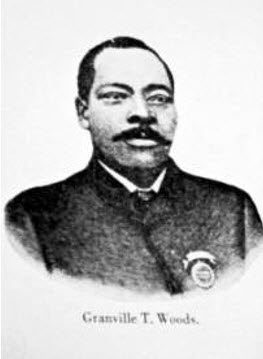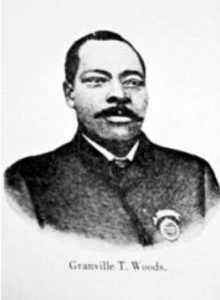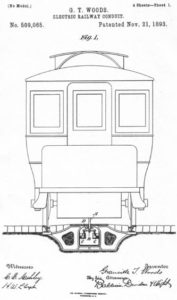
Over the years, the railroads have benefited from a diverse workforce. Most people think of the Transcontinental Railroad as the most varied workgroup with Asians, primarily Chinese, providing the labor to build the railroad in the West. However, railroads have a much more varied history than that. For example, German and Irish immigrants provided a large part of the workforce in the North, while the South utilized slave and convict labor. Of course, railroads and Pullman Porters go hand in hand when examining railroad history as well. However, each week this month, we will highlight an African American inventor and his contribution to the railroads.
Granville T. Woods (1856-1910)
 Granville T. Woods, born in Columbus, Ohio, in 1856, received more than 60 patents during his career. After leaving school at the age of ten to support his family, Woods worked in steel mills, railroads, and steamships. After facing discrimination in his jobs, he opened his own machine shop, Woods Electrical Company, in 1880.[1] Woods first patent was for an improved steam boiler furnace; however, his later patents were mainly for electrical devices.
Granville T. Woods, born in Columbus, Ohio, in 1856, received more than 60 patents during his career. After leaving school at the age of ten to support his family, Woods worked in steel mills, railroads, and steamships. After facing discrimination in his jobs, he opened his own machine shop, Woods Electrical Company, in 1880.[1] Woods first patent was for an improved steam boiler furnace; however, his later patents were mainly for electrical devices.
Woods developed the Synchronous Multiplex Railway Telegraph. This invention allowed moving trains to communicate with train stations which helped everyone know where trains were at all times. Woods also received a patent for the induction, or multiplex, telegraph, which combined the telephone and telegraph, allowing a voice to be transmitted over telegraph lines, increasing the speed of communications. Thomas Edison sued Woods over the patent claiming Edison invented the induction telegraph.[2] Woods won the lawsuit and was subsequently known as “Black Edison.”[3]
 Alexander Graham Bell later bought the induction telegraph patent allowing Wood to focus his energy on railroads. He went on to invent the “third-rail” system for electric railways in 1901. “This was accomplished by removing the moving wire rope and pulleys and installing electrical contactor rails. This was the first system to use rails instead of wires.”[4] The third-rail system continues to be used by electric-power transit systems such as the New York City Subway system.
Alexander Graham Bell later bought the induction telegraph patent allowing Wood to focus his energy on railroads. He went on to invent the “third-rail” system for electric railways in 1901. “This was accomplished by removing the moving wire rope and pulleys and installing electrical contactor rails. This was the first system to use rails instead of wires.”[4] The third-rail system continues to be used by electric-power transit systems such as the New York City Subway system.
—————————————————————————
[1] “Granville T. Woods,” Granville T. Woods – Ohio History Central (Ohio History Connection), accessed February 6, 2022, https://ohiohistorycentral.org/w/Granville_T._Woods.
[2] “Granville Woods,” Lemelson-MIT (Massachusetts Institute of Technology), accessed February 6, 2022, https://lemelson.mit.edu/resources/granville-woods.
[3] Mary Bellis, “Biography of Granville T. Woods, American Inventor,” ThoughtCo (ThoughtCo, January 28, 2020), https://www.thoughtco.com/granville-t-woods-1992675.
[4] David L. Head, “Granville T. Woods,” Bhra: Granville Woods (The Brooklyn Historic Railway Association), accessed February 6, 2022, http://www.brooklynrail.net/Granville_Woods.html.



